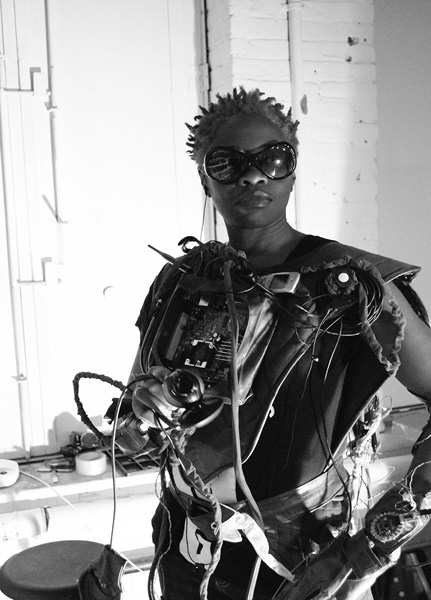
CYBORG NATION: TEKNOTHERAPY
first performed on
April 16, 2011
Proteus Gowanus, Brooklyn, NY
performed six times in 2011
CLARINDA MAC LOW, WALTER POLKOSNIK, ONOME EKEH
New York, NY
173662334c173662334y173662334b173662334o173662334r173662334g173662334@173662334c173662334y173662334b173662334o173662334r173662334g173662334-173662334n173662334a173662334t173662334i173662334o173662334n173662334.173662334n173662334e173662334t
cyborg-nation.net
CYBORG NATION: TEKNOTHERAPY
CLARINDA MAC LOW, WALTER POLKOSNIK, ONOME EKEH
“Cyborg Nation” is a portable performance installation that engages the audience in direct conversation through the use of a self-contained performance environment (or SCoPE). In the SCoPE, miniature technologies are combined to create a piece of functional wearable art, a human-machine hybrid. “Cyborg Nation” joins technological and philosophical investigation with live installation to interrogate how we mediate intimacy through technology, and is fed by an interest in how technology both extends and limits our senses and relationships.
The person wearing the SCoPE communicates with the “audience” solely through phone and emailed text and images. Though the audience is often initially non-plussed that they cannot engage directly with the SCoPE-wearer (or Cyborg), there is a paradoxical instant intimacy to phone contact that weaves a cocoon of false privacy, leading to unexpected revelations. All the interactions are public, so intimacy becomes spectacle. How do you make an empathy machine?
In “Cyborg Nation: Teknotherapy,” the Cyborg acted as a mediator between the “client” and their technological devices. A Cyborg interlocutor (“teknotherapist”) led group and individual sessions conducted, as usual, entirely by cell phone. The clients were given an intake form, and presented problems such as “I can’t get away from my computer” or “Can a machine give me real emotional fulfillment?” The Teknotherapists called on a variety of tactics, including standard psychological tools, imaginative play, and even the startling look of the SCoPE itself. Each session began with a “techno” movement exercise. The Teknotherapist then addressed the problem presented, making it clear that, as the Cyborg, they were qualified to bring in both the human and the machine perspective. Though the sessions were playful, it soon became clear that the “therapy” was addressing a need-people had intense relationships with their devices and nowhere to discuss their very real emotional pain.
Some examples:
A woman needed to buy a new computer, but was genuinely attached to her old computer and all its quirks. (Solution: Acknowledge her attachment to the tool that held such a privileged place in her life, and then let it go.)
An older woman felt outsmarted by her smartphone, and shame at her inability to conquer its operations. (Solution: Accept that the phone was a complex entity; read the operating manual.)
A man wanted a more trusting and open relationship with his computer. (Solution: As he said, “You love the machine, the machine loves you back.”)